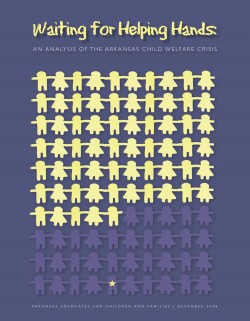
When parents cannot protect their children, the State of Arkansas has the responsibility to do so. The Arkansas Division of Children and Families Services (DCFS) has the main responsibility for children removed from their homes and taken into care. This year, several children have died from abuse while in the Arkansas foster care system. These tragic deaths point out the problems within our foster care system and provide a warning that the safety of other children may be at risk.
This report is Arkansas Advocates for Children and Families’ (AACF) fourth annual report on the performance of the Arkansas child welfare system. As noted in AACF’s previous reports, DCFS performed well on many of its indicators in the early 2000s, but began experiencing a significant decline in performance beginning in 2004. That poor performance has continued and this report shows that our system remains in crisis. Governor Mike Beebe has taken steps to address this crisis but much more remains to be done. We hope this report can be used as a tool to identify problems within the system so that additional steps can be taken to solve these problems. All of our children deserve to grow up in a safe, loving, and stable family.
This is no small task. DCFS caseloads are at 28 cases per family service worker compared to the recommended standard of 15 cases. In the last state fiscal year (SFY), which ended June 30, 2008, 27,672 reports of abuse or neglect were investigated. Of those, 8,834 children in 6,288 reports were founded as true reports of child maltreatment. The majority (nearly 83 percent) of these children are victims of neglect. Over 39 percent of these children are victims of physical abuse and over 37 percent are victims of sexual abuse.
When an investigator finds that a report of abuse or neglect is true, the first and most important decision is whether a child can remain safely in the home. Other decisions must also come quickly: If the child cannot stay at home, what is the best placement? What are the underlying causes of the abuse or neglect? What services does the child need? What services does the family need?
There are many questions to be answered, but this report will focus on two issues: (1) are we keeping our children safe by completing investigations timely and making regular visits to the home or placement; and (2) are we moving children as quickly as possible to permanent homes. We will examine these issues by analyzing performance data from DCFS. The sources of data include the monthly Compliance Outcome Reports (COR), the annual DCFS Report Card, and data from the Adoption and Foster Care Assessment and Reporting System (AFCARS), which DCFS submits twice per year to the federal government.
